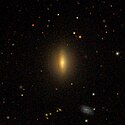NGC 2562
| Galaxie NGC 2562 | |
|---|---|
 | |
| NGC 2562 mit LEDA 86321 (u.) | |
| AladinLite | |
| Sternbild | Krebs |
| Position Äquinoktium: J2000.0, Epoche: J2000.0 | |
| Rektaszension | 08h 20m 23,6s[1] |
| Deklination | +21° 07′ 53″[1] |
| Erscheinungsbild | |
| Morphologischer Typ | S0/a: / LINER[1] |
| Helligkeit (visuell) | 13,0 mag[2] |
| Helligkeit (B-Band) | 13,9 mag[2] |
| Winkelausdehnung | 1,0' × 0,7'[2] |
| Positionswinkel | 3°[2] |
| Flächenhelligkeit | 12,5 mag/arcmin²[2] |
| Physikalische Daten | |
| Zugehörigkeit | Cancer-Cluster WBL 178 NGC 2563-Gruppe LGG 158[1][3] |
| Rotverschiebung | 0.016886 ± 0.000006[1] |
| Radialgeschwindigkeit | (5062 ± 2) km/s[1] |
| Hubbledistanz H0 = 73 km/(s • Mpc) | (222 ± 16) · 106 Lj (68,2 ± 4,8) Mpc [1] |
| Durchmesser | 65.000 Lj[4] |
| Geschichte | |
| Entdeckung | William Herschel |
| Entdeckungsdatum | 13. Februar 1787 |
| Katalogbezeichnungen | |
| NGC 2562 • UGC 4345 • PGC 23395 • CGCG 119-063 • MCG +04-20-031 • 2MASX J08202368+2107533 • GC 1645 • H III 607 • h 500 • GALEXASC J082023.60+210755.8 • NSA 084185 • LDCE 571 NED009 | |
NGC 2562 ist eine Linsenförmige Galaxie mit aktivem Galaxienkern vom Hubble-Typ S0/a im Sternbild Krebs auf der Ekliptik. Sie ist schätzungsweise 220 Millionen Lichtjahre von der Milchstraße entfernt und hat einen Durchmesser von etwa 65.000 Lichtjahren.
Im selben Himmelsareal befinden sich die Galaxien NGC 2560, NGC 2563, NGC 2570, IC 2293.
Das Objekt wurde am 13. Februar 1787 von Wilhelm Herschel entdeckt.[5]
Weblinks
Einzelnachweise
Auf dieser Seite verwendete Medien
Autor/Urheber: Sloan Digital Sky Survey, Lizenz: CC BY 4.0

Angle of view: 4' × 4' (0.3" per pixel), north is up.
Details on the image processing pipeline: https://www.sdss.org/dr14/imaging/jpg-images-on-skyserver/